APAH: Unit 4 - Islamic, Buddhist, & Hindu Art
1/91
Name | Mastery | Learn | Test | Matching | Spaced |
|---|
No study sessions yet.
92 Terms
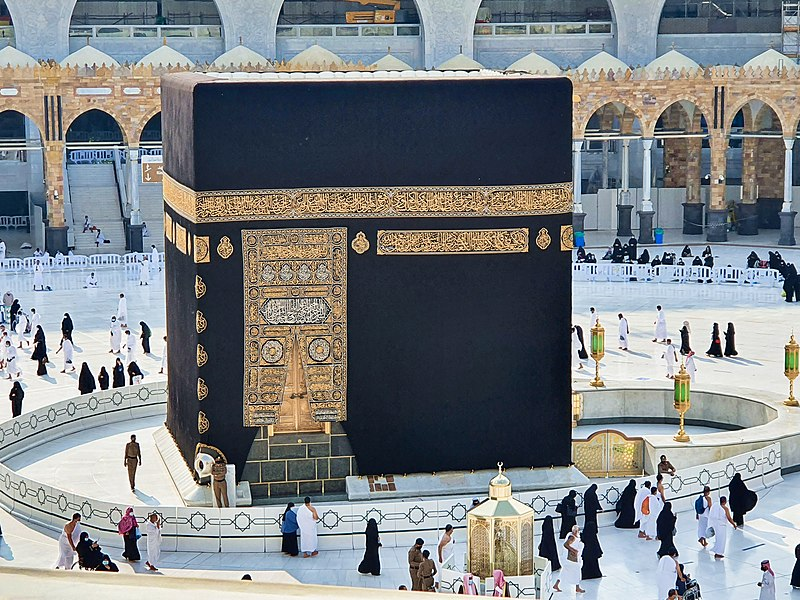
Kabba

Kabba (culture & location)
Pre-Isalmic/Islamic; Mecca, UAE
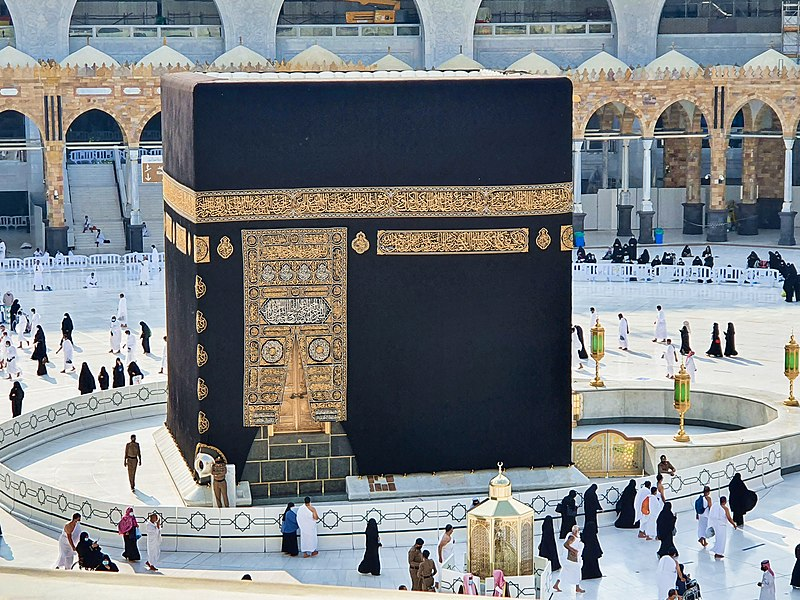
Kabba (date & material)
631-632 CE; Granite masonry covered with silk embroidered with gold & silver thread
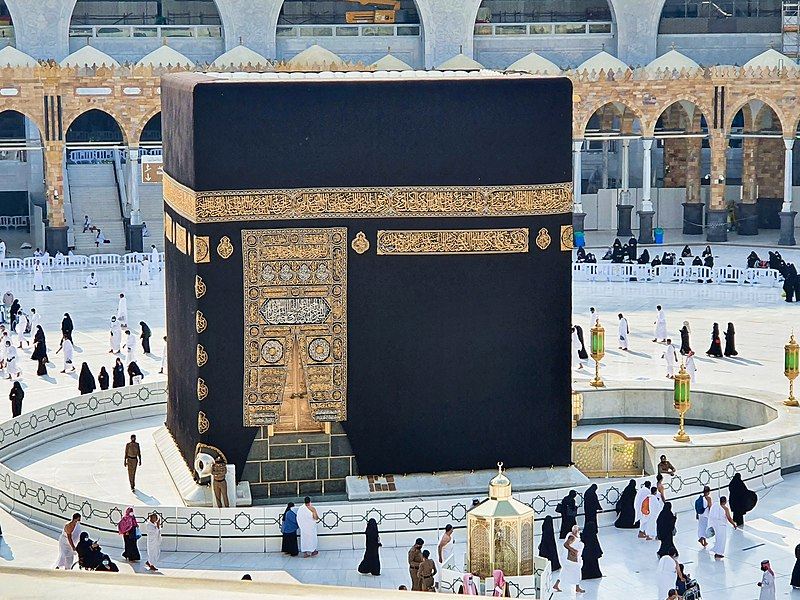
Kabba (use & facts)
Isalmic worship
Mecca = holiest city in Islam, destination of Hajj, circle Kabba 7 times (Tawaf ritual circumambulation)
symbol of unity of believers in their worshipping of God
silk has calligraphic verses of the Qur’an on it
Muslims required to do Hajj at least once
Muslim “House of God”
location determines the qibla wall of mosque (Muslims face Mecca when praying)
said to be built by Ibrahim (Abraham) & Ismael, rededicated by Muhammad
curtain of black silk called kiswah (replaced annually)
black stone on eastern side is only part of original structure left
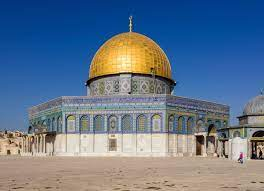
Dome of the Rock
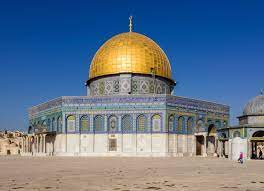
Dome of the Rock (culture & location)
Umayyad Dynasty (Arabic); Jerusalem, Israel

Dome of the Rock (date & material)
691-692 CE; Stone masonry, wooden roof, decorated with glazed ceramic tile, mosaics & gilt aluminum with bronze dome
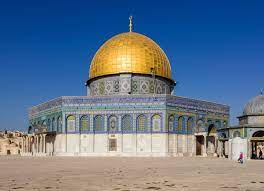
Dome of the Rock (use & facts)
unknown purpose
patron: the Caliph, Abd al-Malik
mosaics: Byzantine & Sasanian (Persian) crowns w/ in plant motifs, vessels, & winged crowns
not a mosque
believed to be rock where Adam was buried, Abraham nearly sacrificed Isaac, & where Muhammad ascended to heaven (Night Journey), & location of the Temple of Jerusalem
iconography includes references to pre-Islamic civilization
one of the oldest Muslim structures with some of the oldest Qur’an verses
pilgrims circumambulate inside
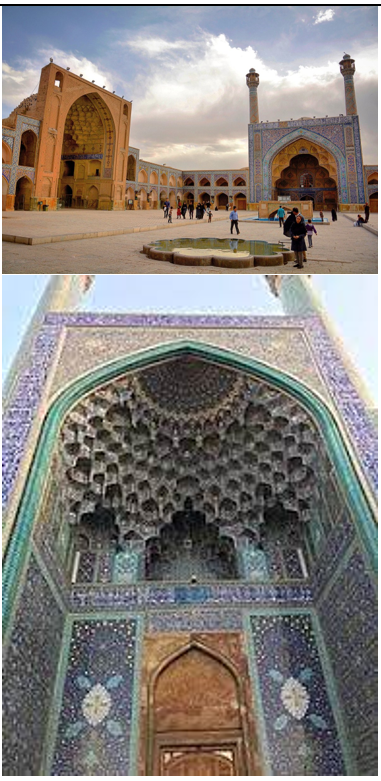
Great Mosque at Isfahan
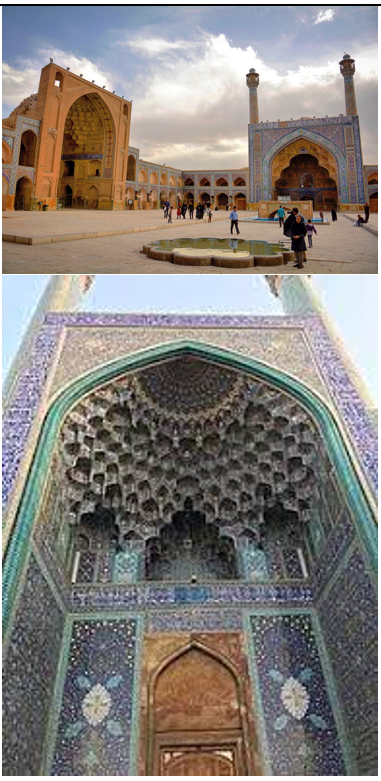
Great Mosque at Isfahan (culture & location)
Isfahan, Iran; Islamic
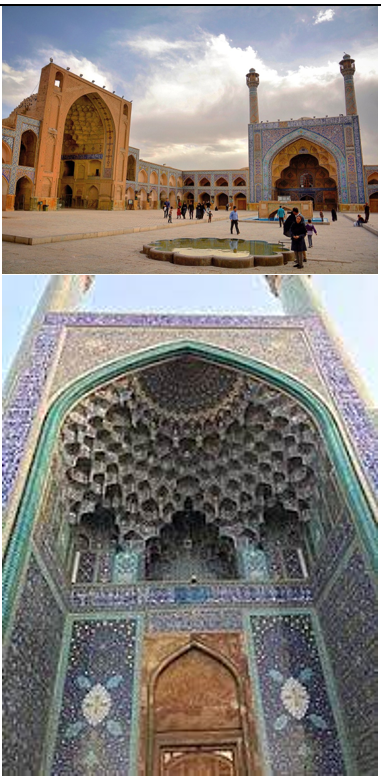
Great Mosque at Isfahan (date & material)
c. 700 CE (cont. 11th-17th centuries CE); brick, wood, plaster, & ceramic tile
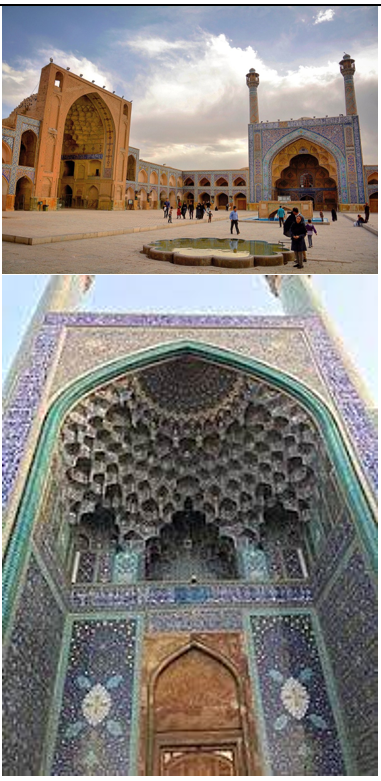
Great Mosque at Isfahan (use & facts)
Isalmic place of worship
mosque known for integration into urban community because of many gates & entrances
umma = Islamic community
great mosque fits all the men in the city for Friday prayers
result of history of construction & reconstruction, collection of structures built in different time periods
interior courtyard bc Muhammad started preaching in his courtyard
water essential to Islam (ritual ablution/washing)
Muqarnas = decorative vaulting on the surface of a vault or dome subdivided into niche-like cells (aka stalactite vaulting or honeycomb vaulting)
muqarnas created a smooth, decorative transition zone
iwan = rectangular vaulted space in an Islamic building closed on 3 sides & open on the 4th
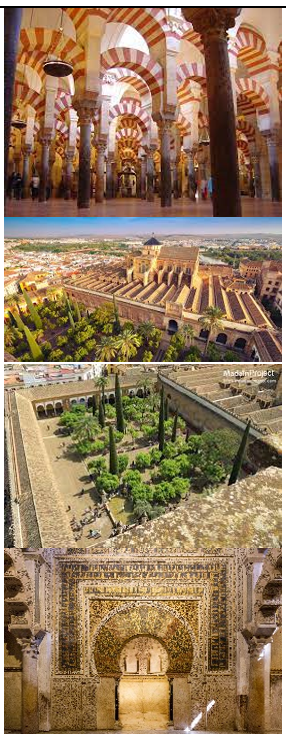
Great Mosque at Cordoba

Great Mosque at Cordoba (culture & location)
Umayyad Dynasty (Arabic/Islamic); Cordova, Spain

Great Mosque at Cordoba (date & material)
c. 785-786 CE; white stone, red brick, marble
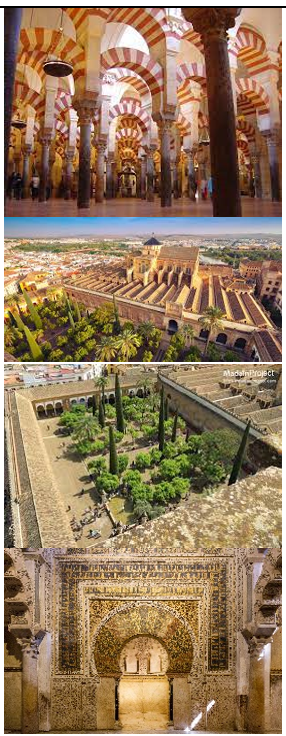
Great Mosque at Cordoba (use & facts)
Islamic place of worship during Muslim (Moors) rule of Spain
“La Mezquita”
patron: Abd al-Rahmen
8th-10th century
post-Reconquista church built on top
columns are spolia from Roman structures in Spain
Roman pagan church -> Islamic mosque -> Christian church
double-horseshoe arches for toller roof
white stone & red brick voussoirs (curved stones in an arch)
dome over mihrab (niche indicating direction of Mecca) inspired by Byzantine squinches
Kufic (holy) calligraphy on walls
Cordova was a hub of intellectual thought (Arabs brought knowledge to Spain)
mosque expanded in 962 CE, tesserae mosaic added
squinches support dome over mirab
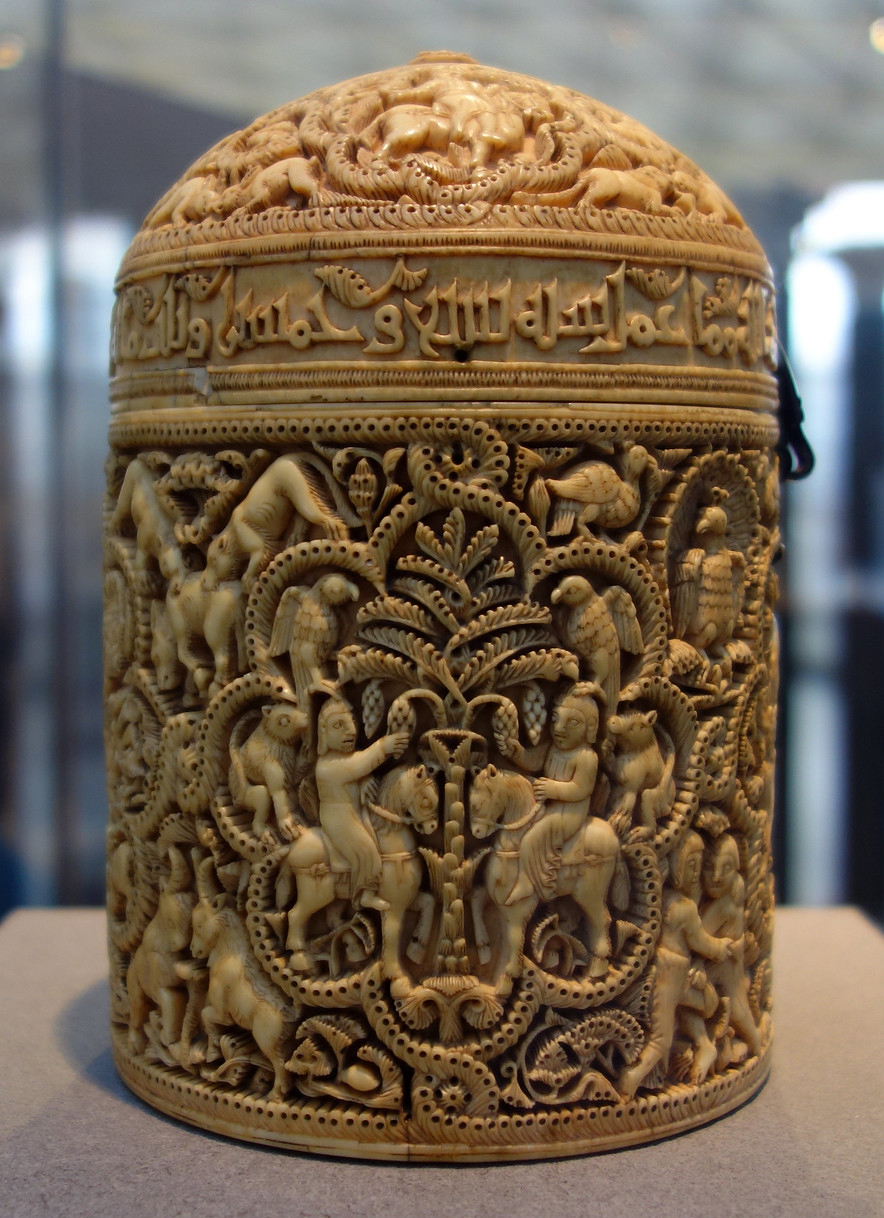
Pyxis of al-Mugira
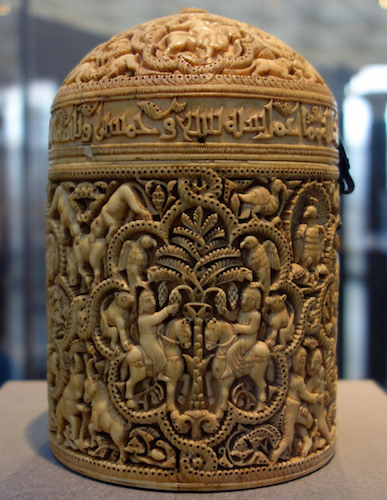
Pyxis of al-Mugira (culture & location)
Islamic; Umayyad Dynasty
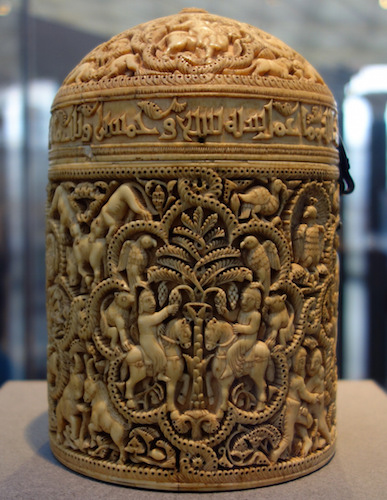
Pyxis of al-Mugira (date & material)
986 CE; ivory

Pyxis of al-Mugira (use & facts)
Container for cosmetics, aromatics, or jewelry
gift for caliphate’s younger son
calligraphy names the owner & tells its date
“horror vacui”
vegetal & geometric motifs surround 8 medallions showing pleasure activities of the court: hunting, falconry, music, sports
can have people on it bc it is non-religious
functional piece showing legitimacy of royal power
royal iconography=scepter & lion
bestowed as gifts on important occasions

Ahlambra

Ahlambra (culture & location)
Islamic; Granada, Spain

Ahlambra (date & material)
1354-1391 CE; sun-dried brick

Ahlambra (use & facts)
palace & fortress
last stronghold of the Muslim empire in Spain
build above the city of Grenada
light & airy interior
palace & fortress
nicknamed “The Red Palace”
small bubbling fountains cool the palace in the summer
surrounded by El Generalife on one side
use of water & garden = paradise
Hall of the Two Sisters is named after the 2 slabs of marble/rock in it
Court of the Lions includes thin columns & stucco roofs with a basin supported on the backs of 12 lions spitting water into 4 streams (4 rivers of paradise) & pavilions for living space
many rooms including the Court of Myrtles, Hall of Ambassadors, Comares Palace, Generalife’s Garden, Hall of the Two Sisters, & many more
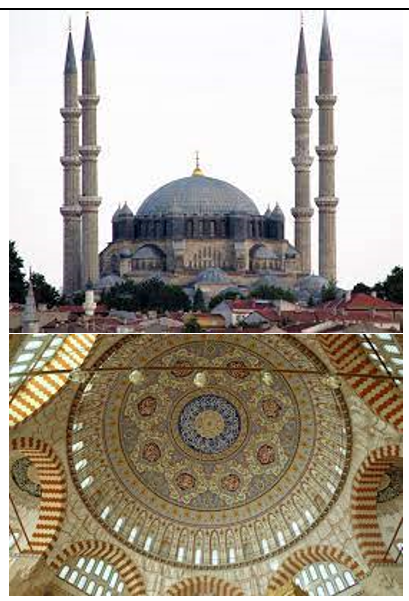
Mosque of Selim II
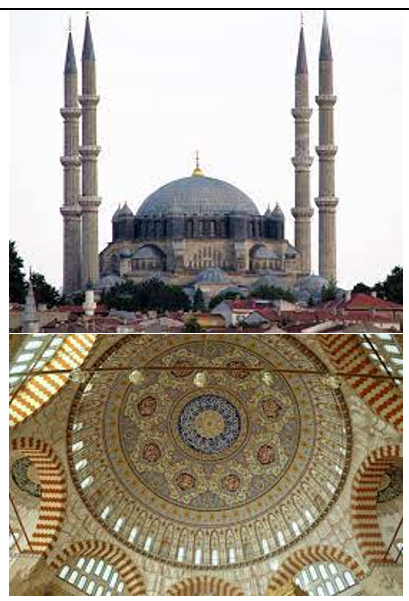
Mosque of Selim II (culture & location)
Islamic; Edirne, Turkey
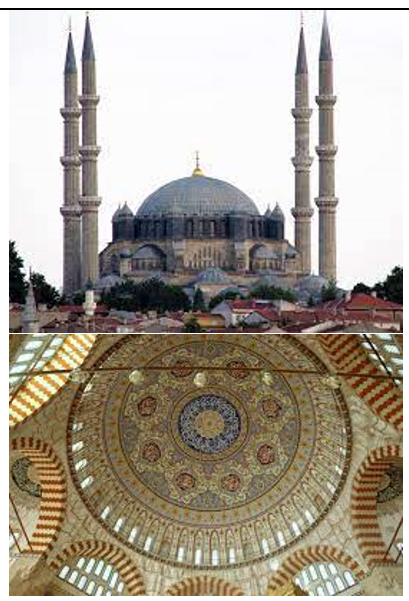
Mosque of Selim II (date, material, & creator)
1568-1575 CE; stone mixed with brick; Sinan

Mosque of Selim II (use & facts)
Islamic place of worship
octagonal support system created by 8 pillars embedded in a square shell of walls
4 semidomes at corners
Sinan was the architect for Ottoman emperor Suleyman the Magnificant
thin, high minarets
dome with windows = brightly lit interior
small domes in the corner transition the square base to round dome
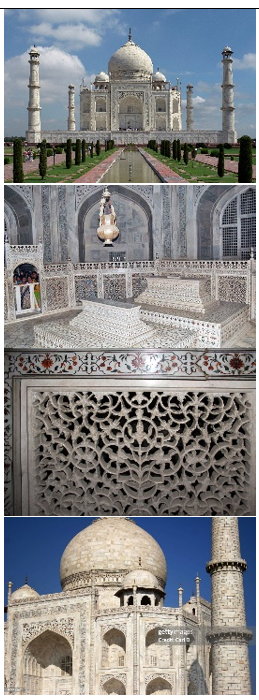
Taj Mahal

Taj Mahal (culture & location)
Islamic; Agra, India
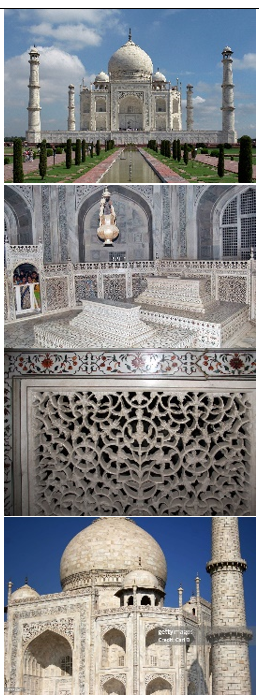
Taj Mahal (date & material)
1632-1648 CE; stone, marble, & semi-precious stone
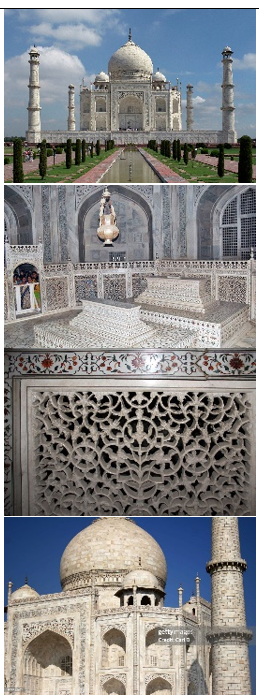
Taj Mahal (use & facts)
tomb/mausoleum
garden surrounding it represents garden of paradise where the dome is reflected in its pool
built by Shah Jahan for his wife Mumtaz Mahal who died giving birth to her 14th child (maybe to show his power?)
Jahan & Mumtaz buried next to each other
walls inlaid with calligraphy & floral arabesques made with coral, garnet, lapis, carnelian, & turquoise
onion dome reflects shifting light
gardens in geometric arrangements in 4 or its multiples (4 is holiest number in Islam)
trees are either Cyprus (signifying death) or fruit trees (signifying life)
Jali screens for privacy around royal cenotaphs (empty tombs
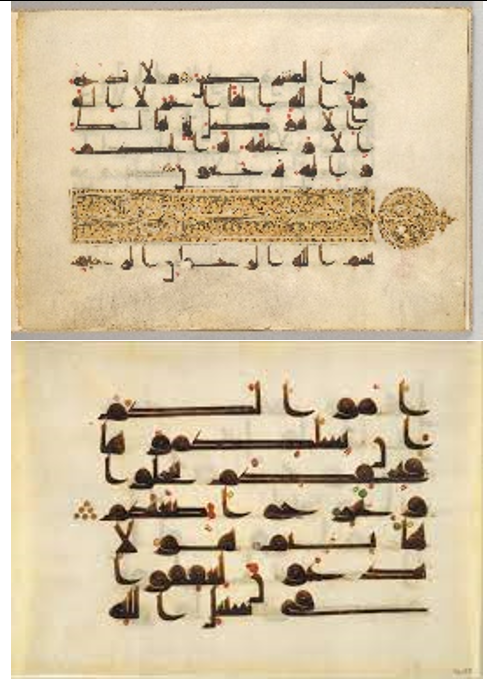
Folio of Qur’an
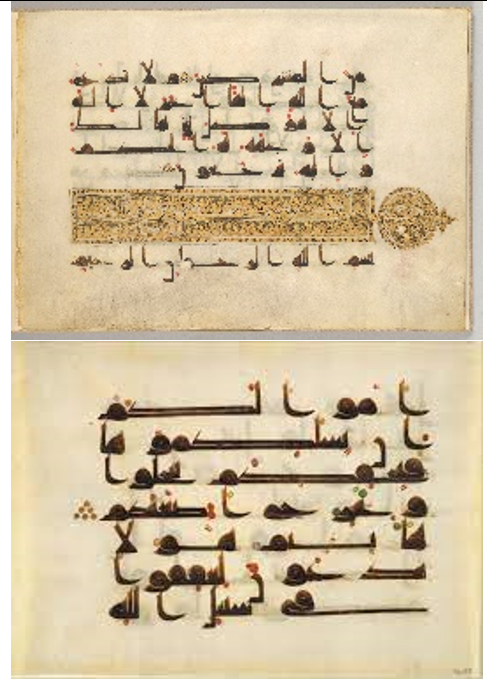
Folio of Qur’an (culture)
Islamic
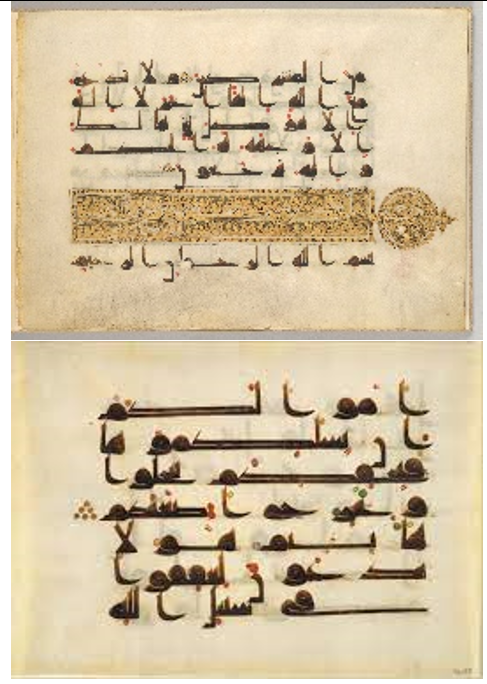
Folio of Qur’an (date & material)
before 911 CE; ink color & gold on parchment (vellum) written in Arabic

Folio of Qur’an (use & facts)
illuminated manuscript, sign of wealth
folio = page
read right to left
chapter title (sura) in gold & elaborately decorated
black text & red pronunciation marks
expensive materials show importance & power of book
luxury shows importance of patron
Qur’an = recitation
Arabic vowels not written usually (are here for pronunciation)
large format due to sharing of the book
single pages taken out to sell
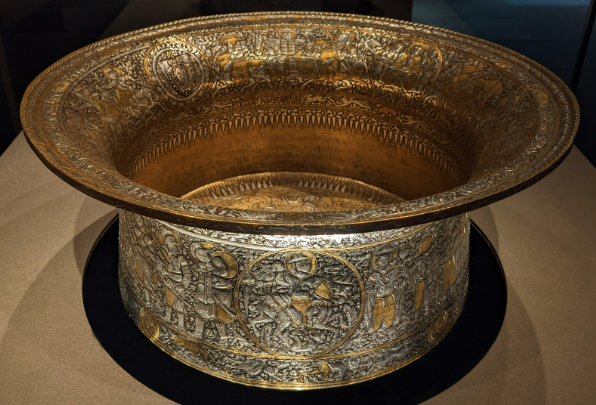
Basin (Baptistere St. Louis)

Basin (Baptistere St. Louis) (culture & creator)
Egyptian or Syrian'; Mohammed ibn al-Zain
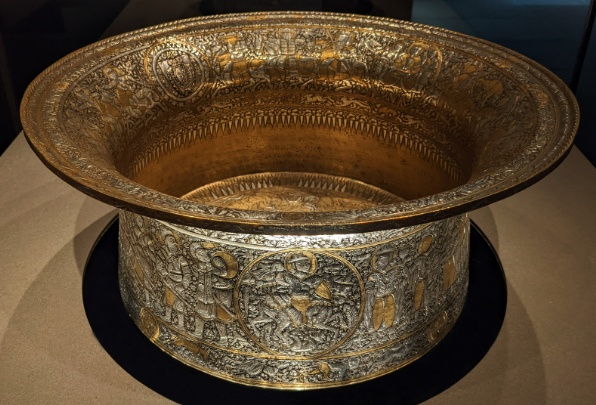
Basin (Baptistere St. Louis) (date & material)
1320-1340 CE; brass inlaid with gold & silver
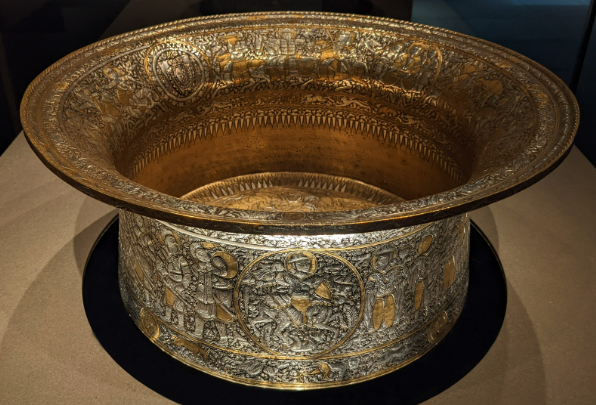
Basin (Baptistere St. Louis) (use & facts)
Banqueting vessel for wealthy Mamluk; ended up in France & used for 17th century baptisms of French royal children
Mamluks (ethnic Turks) were a group of warrior slaves who took control of several Muslim states & established a ruling dynasty in Egypt & Syrian from 1250-1517 (Ottoman Conquest)
ex of an object produced for one ceremonial context but used for another
originally banqueting vessel for wealthy Mamluk, ended up in France & used for 17th century baptisms of French royal children
flower motif later became fleur-de-lis
friezes of horsemen, procession of dignitaries, & coat-of-arms; floor covered with interconnecting sea animals
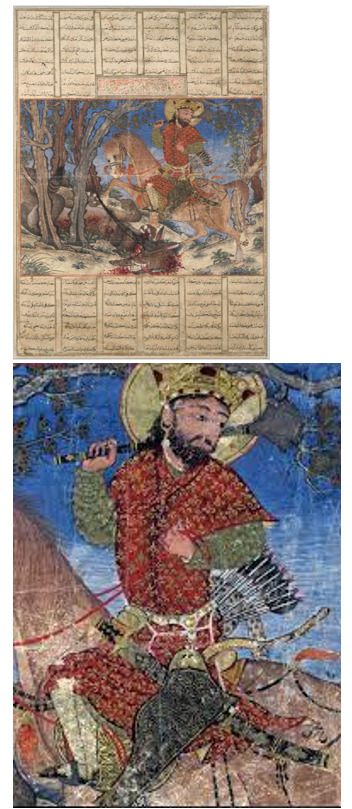
Bahram Gur Fights the Karg from the Great Mongol Shahnameh
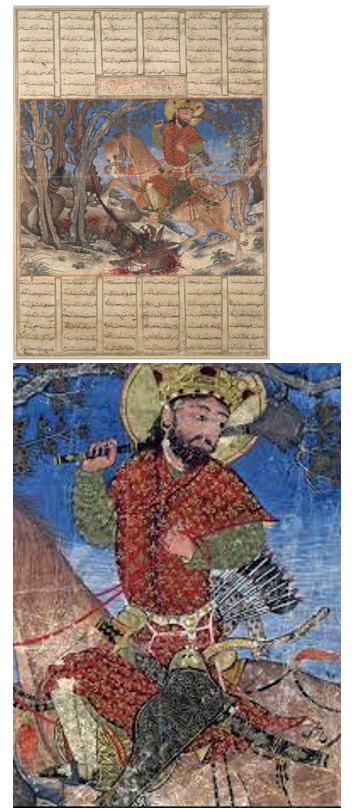
Bahram Gur Fights the Karg from the Great Mongol Shahnameh (culture & location)
Mongol; Iran
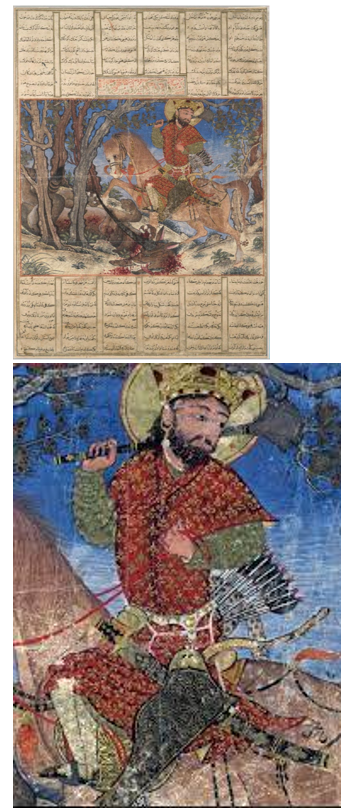
Bahram Gur Fights the Karg from the Great Mongol Shahnameh (date & material)
c. 1330-1340 CE; ink, colors, gold, & silver on paper (folio)
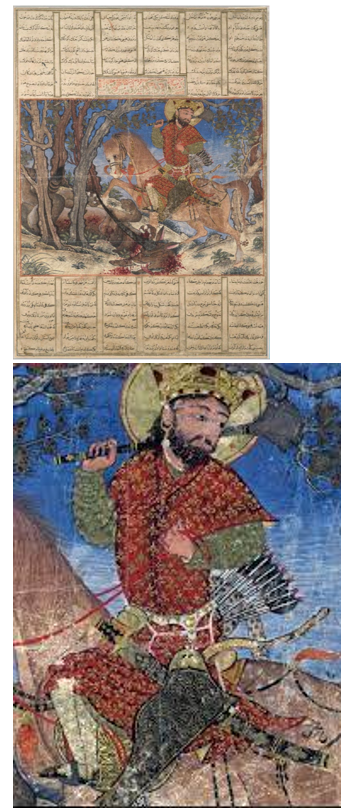
Bahram Gur Fights the Karg from the Great Mongol Shahnameh (use & facts)
Illustrated folk tales, symbolizing just rule triumphing over chaos & disorder
depicts brave deeds of a Persian king who singlehandedly defeated the monstrous Karg (horned wolf)
artists fulfilled their patron’s strong desire to identify with the noble, virtuous, & powerful warrior-kings of ancient Persia
depicted Bahram V (nickname Bahram Gur bc “gur” = swift/fast); known for warfare, chivalry, & romance
only 57 folios from the Great Mongol Shahnameh survived
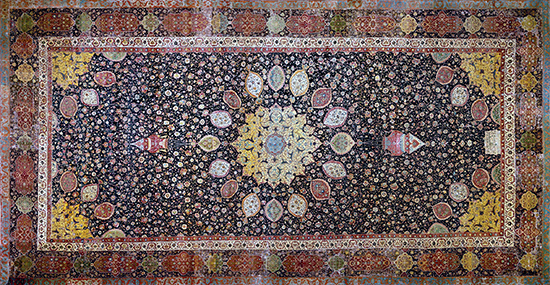
Ardabil Carpet
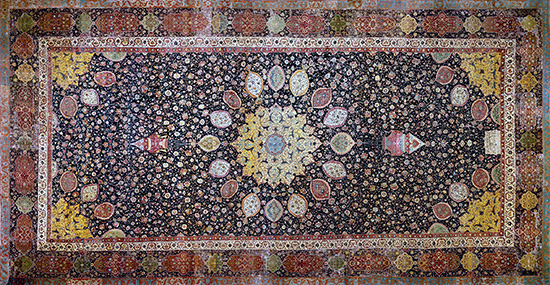
Ardabil Carpet (culture)
Islamic/Persian
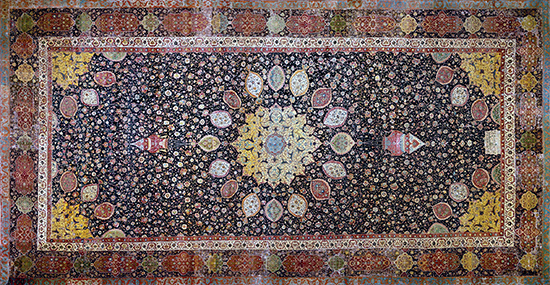
Ardabil Carpet (date & material)
1539-1540 CE; silk on wool
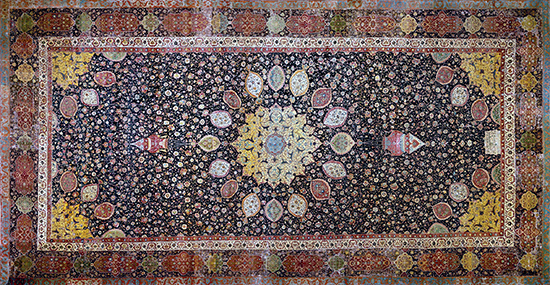
Ardabil Carpet (use & facts)
prayer carpet
one of a matched set
originally at funerary mosque of Shayik Safial-Din
massive size, made be men
center medallion seems to represent dome & corners are squinches, flanked by mosque lamps
all natural dyes (pomegranate rind & indigo)
wool holds dye better than silk
more knot /sq in increases detail & value (this one has 340/sq in)
high knot count allowed for inclusion of intricate design & pattern
10 people could work on it at once
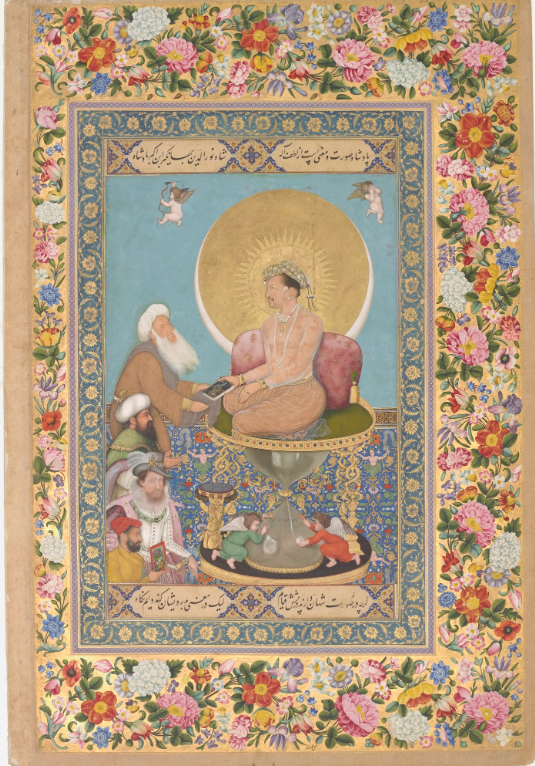
Jahangir Preferring a Sufi Shaikh to Kings

Jahangir Preferring a Sufi Shaikh to Kings (culture & creator)
Persian; Bichtir
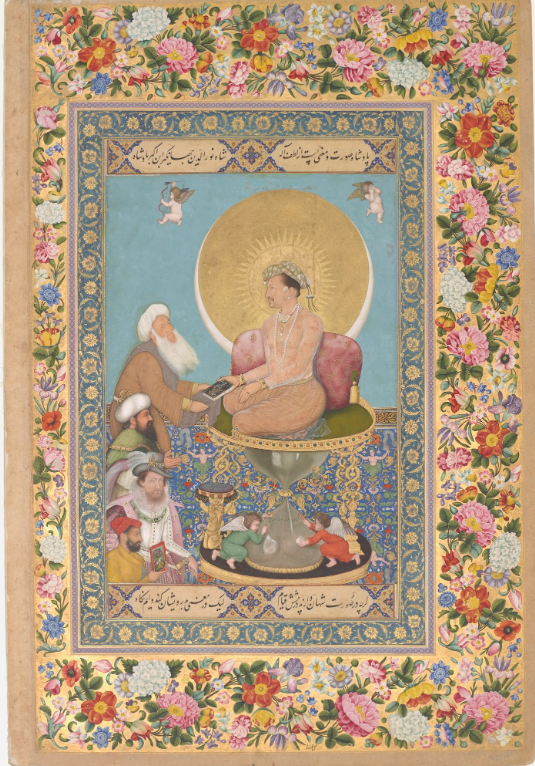
Jahangir Preferring a Sufi Shaikh to Kings (date & material)
1615-1618 CE; opaque watercolor, gold, & ink on paper
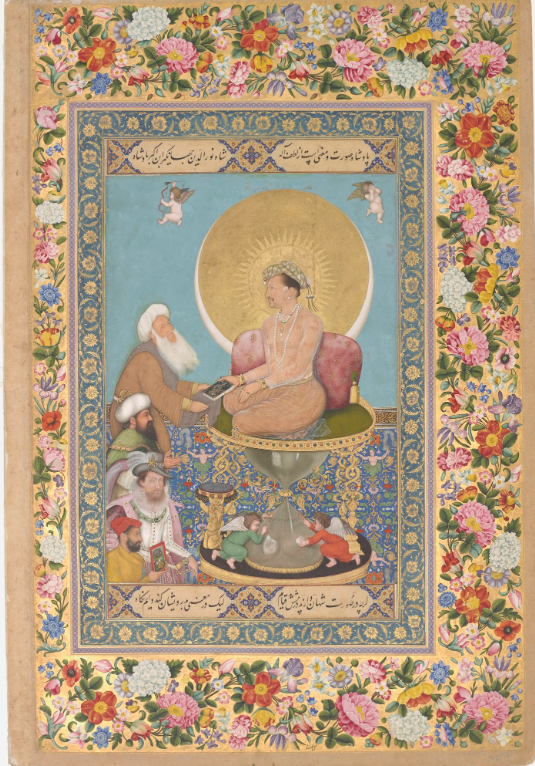
Jahangir Preferring a Sufi Shaikh to Kings (use & facts)
Depiction of royal power favoring the spiritual (holy man) over the worldly (other kings)
Jahangir faces four bearded men of varying ethnicity standing in a receiving line format on blue carpet with arabesque flower designs & fanciful beast motifs
from “St. Petersburg Album”
almost on par with the Emperor is the Sufi Shaikh (Jahangir only deals with the holy man)
second in importance the Ottoman Sultan in gold-embroidered green & turban
third figure is King James I of England in European attire
final man is artist himself
includes flames radiating from emperor’s head, sun & moon (harmony)
emperor is elevated & largest = most powerful
hourglass & cupids are European

The Court of Gayumars from the Shahnameh of Shah Tahmasp I

The Court of Gayumars from the Shahnameh of Shah Tahmasp I (culture & location)
Iran; Persian/Savavid
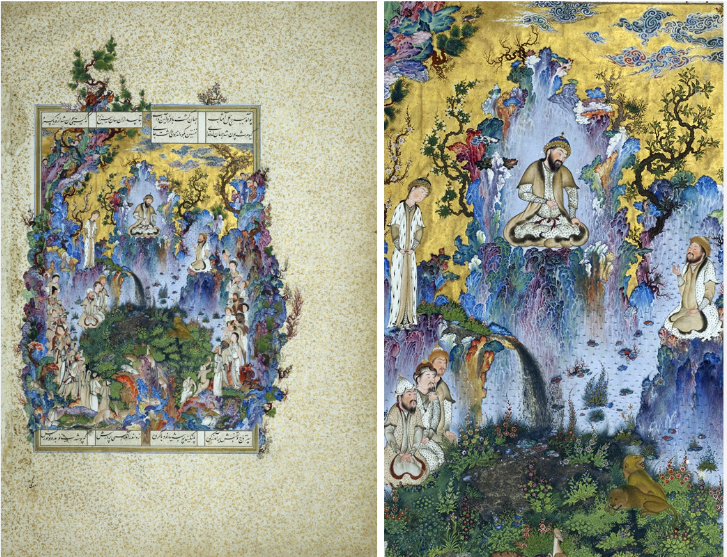
The Court of Gayumars from the Shahnameh of Shah Tahmasp I (date, material, & creator)
c. 1522 CE; opaque watercolor, ink gold, silver on paper (folio); Sultan Muhammad
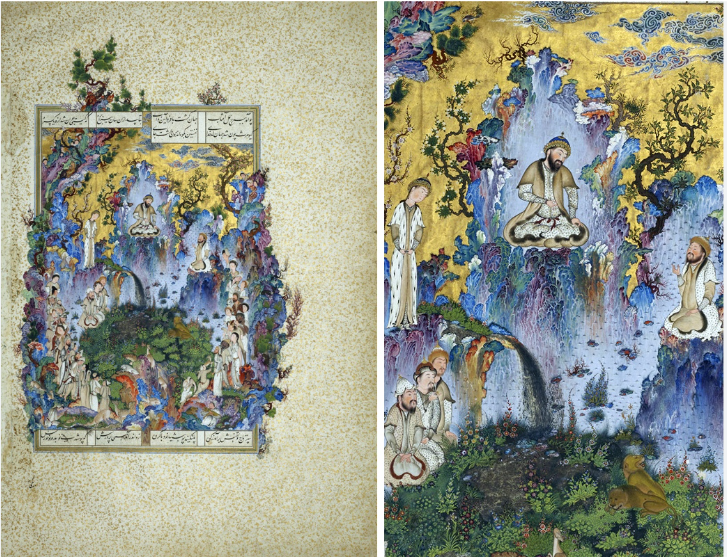
The Court of Gayumars from the Shahnameh of Shah Tahmasp I (use & facts)
Illuminated page from epic poem describing the history of kingship in Persia (present-day Iran)
Shahnameh (Persian book of kings) composed by poet Firdawsi c. 1000 CE & incorporates older oral stories on the history of Persia
Gayumars was the first King of Persia; ruled when people exclusively wore leopard pelts
parallels between content of painting & calligraphic text
stylistic similarities between the swirling blue-gray floating clouds & trees to Chinese art
Persian artists (especially Safavids) used Chinese sources in visual motifs & techniques
Safavids & Mongols intermixed, leading to people depicted with Asian figures
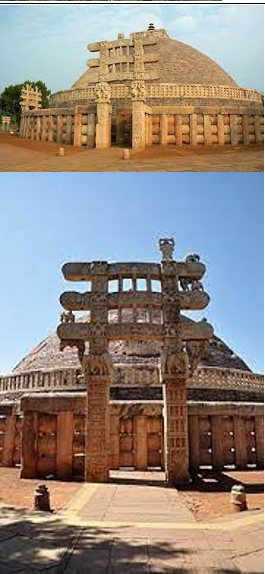
Great Stupa
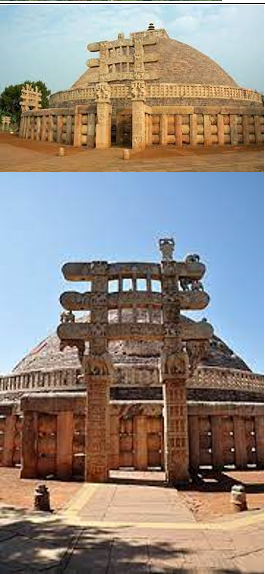
Great Stupa (culture & location)
Buddhist/Indian; Sanchi, India
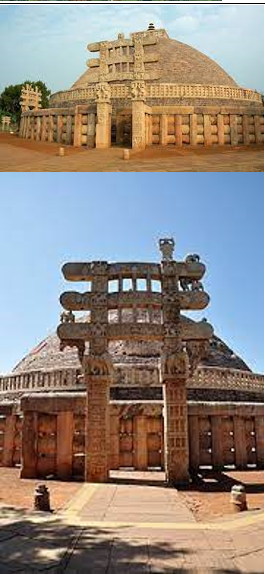
Great Stupa (date & material)
3rd century BCE to 1st centory CE; stone masonry & sandstone
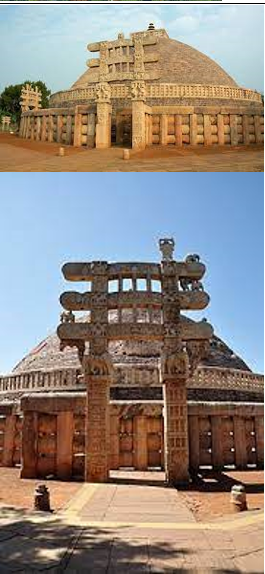
Great Stupa (use & facts)
Buddhist place of worship
stupa = place to venerate Buddhist saints
solid mount with believed to be saint’s (Budda’s) remains inside
pilgrims circumambulate around the mound
Torana = gate at 4 cardinal points
yakshi – female fertility figures in Hindu, Buddhist, & Jain faiths (wide hipped & voluptuous)
chatras= symbols of royalty & protection seen on top of the yakshi (axis mundi-axis connecting to world) & apex of stupa
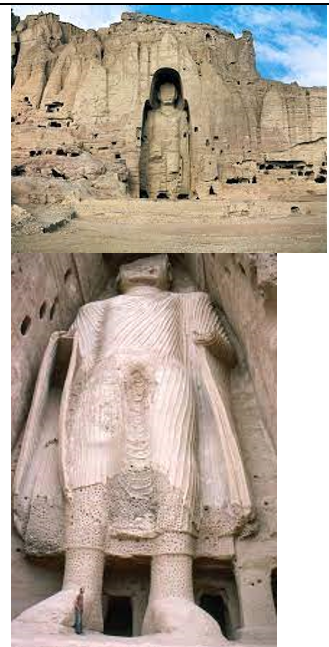
Baymayan Buddhas

Baymayan Buddhas (culture & location)
Buddhist; Bamayan, Afghanistan
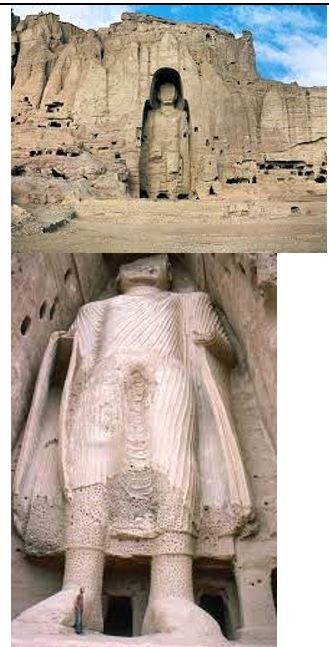
Baymayan Buddhas (date & materials)
4th century CE; sandstone (live rock)
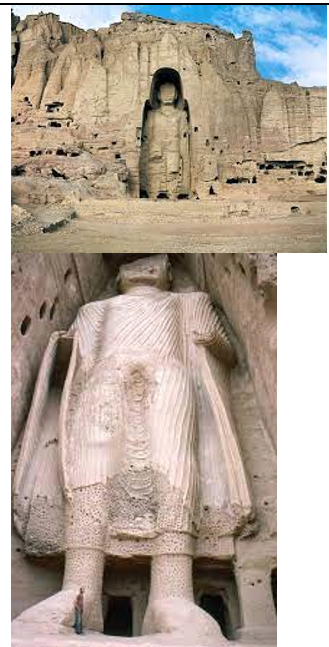
Baymayan Buddhas (use & facts)
Buddhist holy site along the Silk Road
Bayaman was at the Western end of the Silk Road
originally covered with pigment & gold
destroyed by the Taliban in 2001
show both Hellenistic influence dating back to Alexander the Great & Indian Buddhist influence (prevailing until Arab Muslim conquest – 9th century)
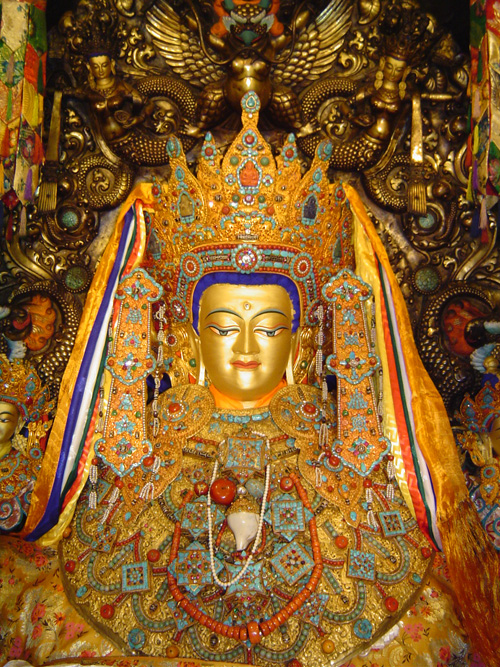
Jowo Rinpoche
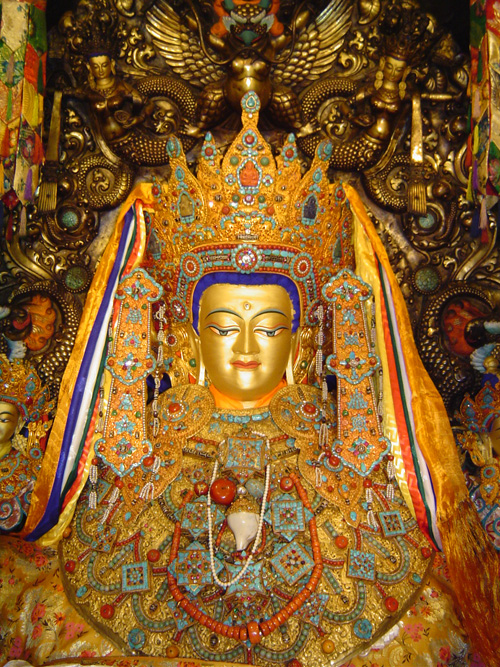
Jowo Rinpoche (culture & location)
Buddhist; Jokang Temple, Lhasa, Tibet
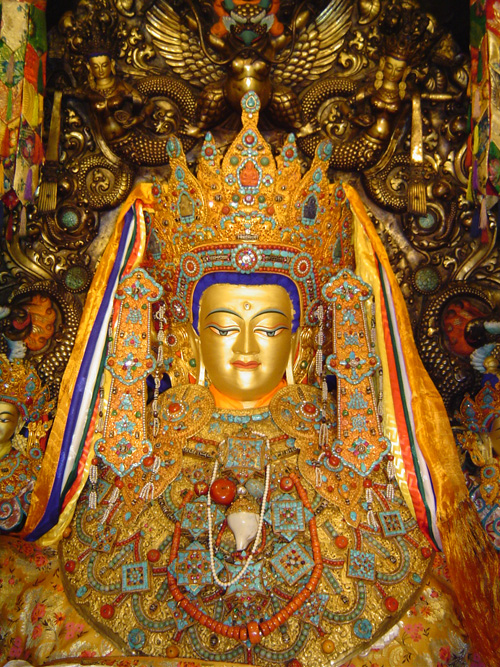
Jowo Rinpoche (date, material, & creator)
641 CE; Vikwakarma; gilt metal with semiprecious stones & paint
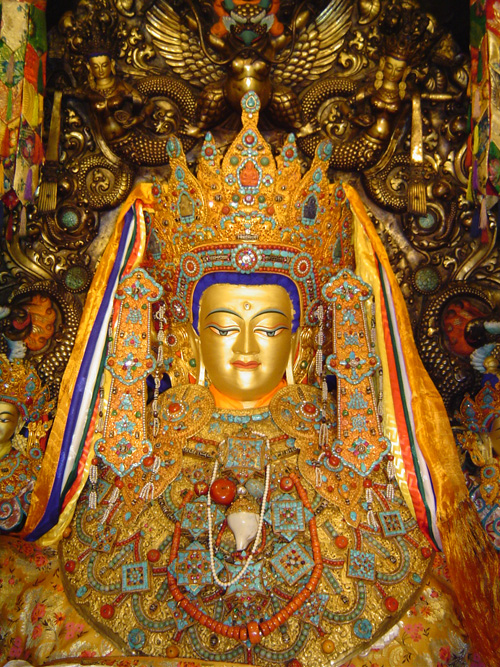
Jowo Rinpoche (use & facts)
jowo = Lord
temple founded in 647 CE by 1st ruler of unified Tibet
part of statue found in trash (after Chinese Cultural Revolution & occupation of Tibet) & part was in a home China
not sculpted from life portrait of Buddha
image holds cultural & religious importance bc it depicts a young Buddha
veneration done by dressing the sculpture or feeding it
believed to be direct lineage to the Buddha & most accurate portrait of the Buddha Shakyamuni
rinpoche = precious one
seated in lotus position
left hand in mudra (hand gesture) of meditation & right hand in gesture of “calling the earth to witness” = together signifies Enlightenment
shown in thin monk’s robe, but dressed in jeweled crown
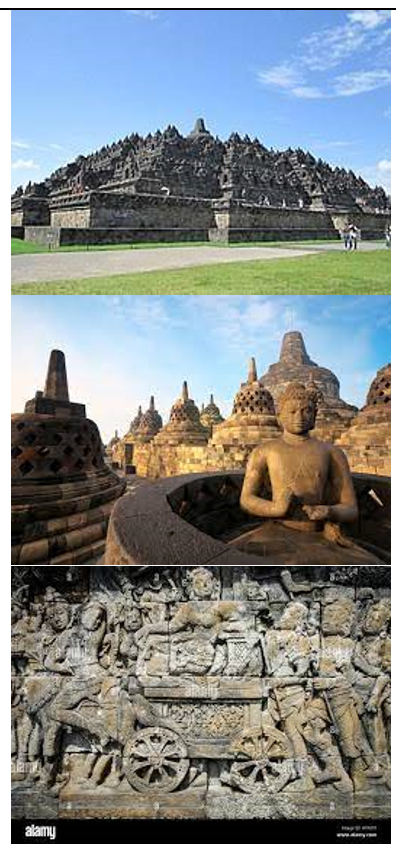
Borobudur Temple

Borobudur Temple (culture & location)
Buddhist; Java, Indonesia
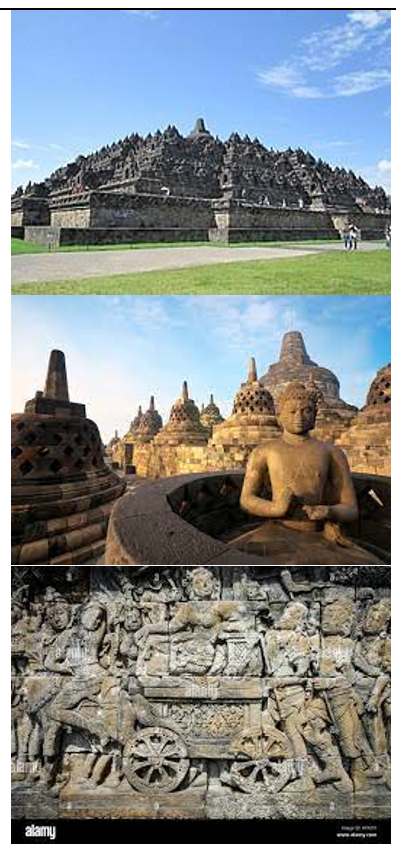
Borobudur Temple (date & material)
c. 750-852 CE; volcanic stone masonry
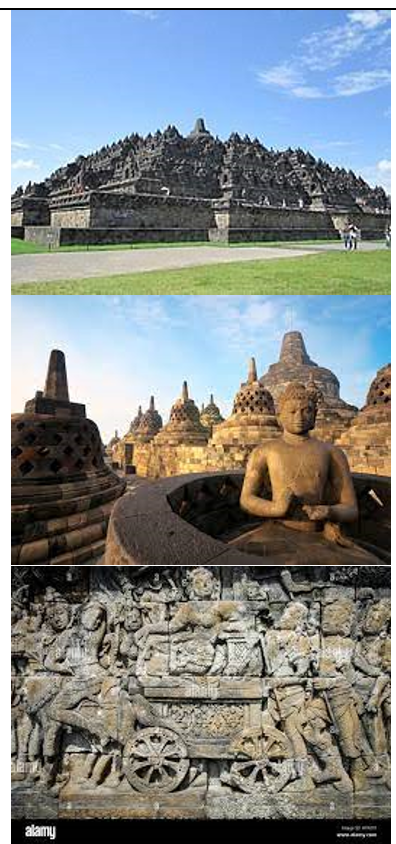
Borobudur Temple (use & facts)
includes relief sculpture showing Queen Maya on her way to give birth to Buddha
built in 9th century & rediscovered by Sir Thomas Stanford Raffles in 1815
buried by volcanic ash & jungle for 100 years
consists of 9 stacked platforms, 6 square & 3 circular, & a central dome
decorated with 2600+ relief carvings
each platform is topped with Budda statues, each seated within a stupa
world’s largest Buddhis temple
combines symbolic forms of stupa (Buddhist), mountain temple (Hindu), & the mandala (Buddhist, square + circle = heaven)
pilgrims begin at base of mountain & ascend to the top before circumambulating
holds larges & most complete collection of Buddhist reliefs in the world
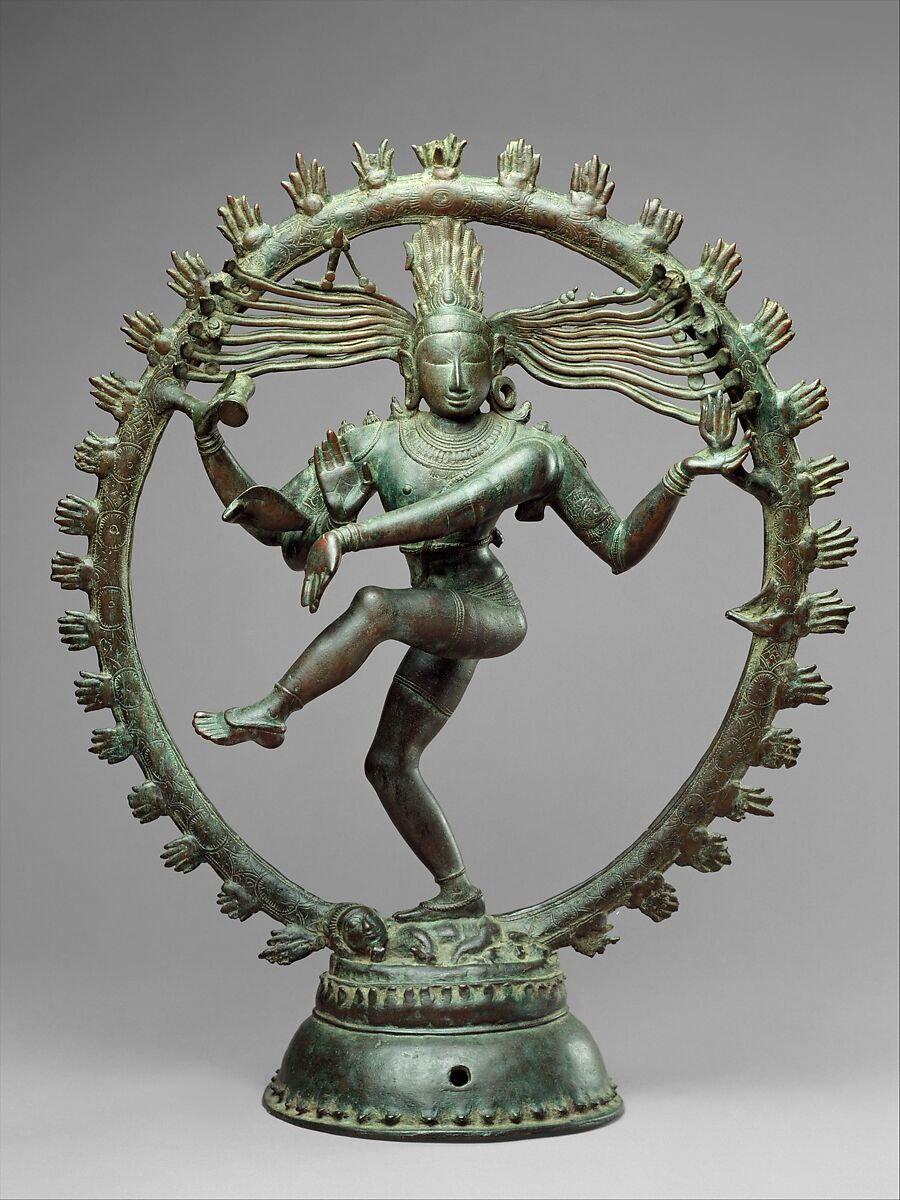
Shiva Nataraja
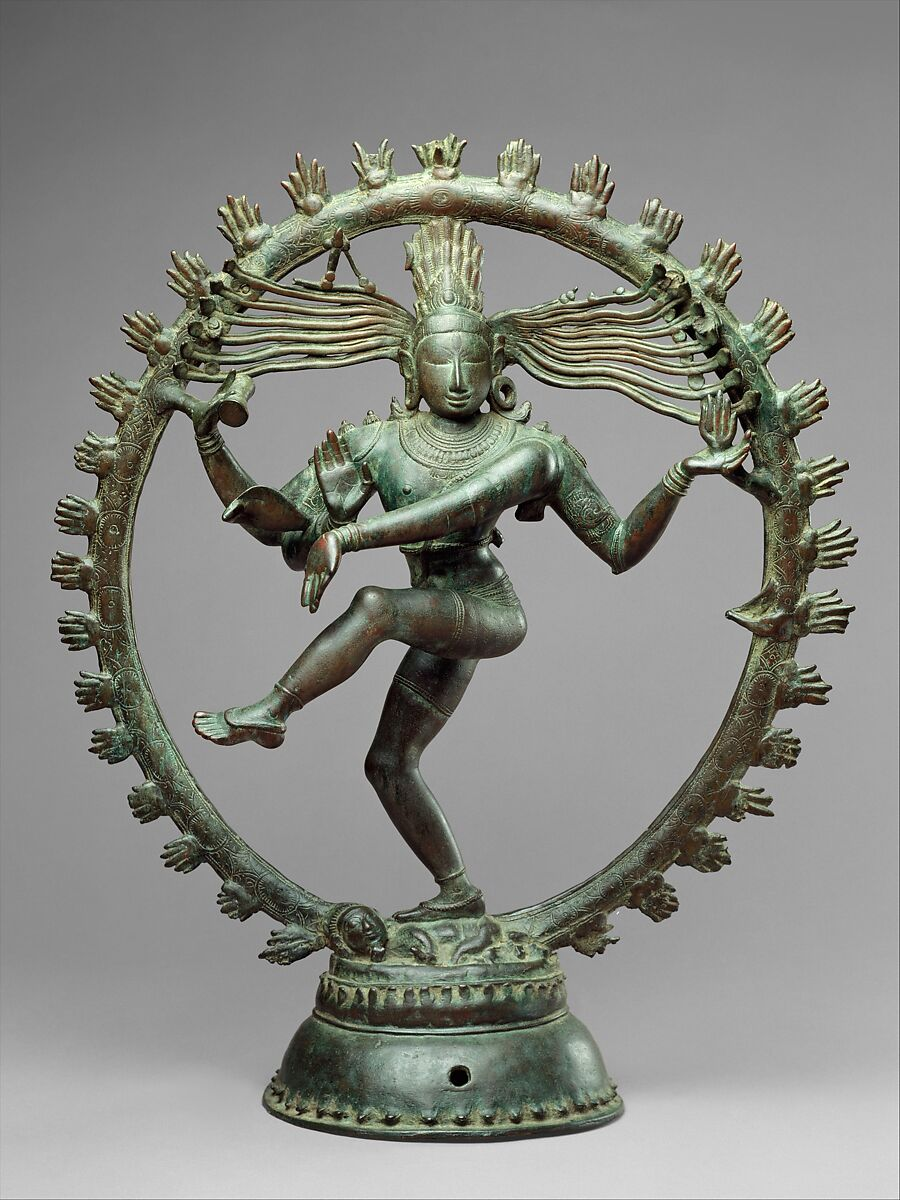
Shiva Nataraja (culture & location)
Hindu; India
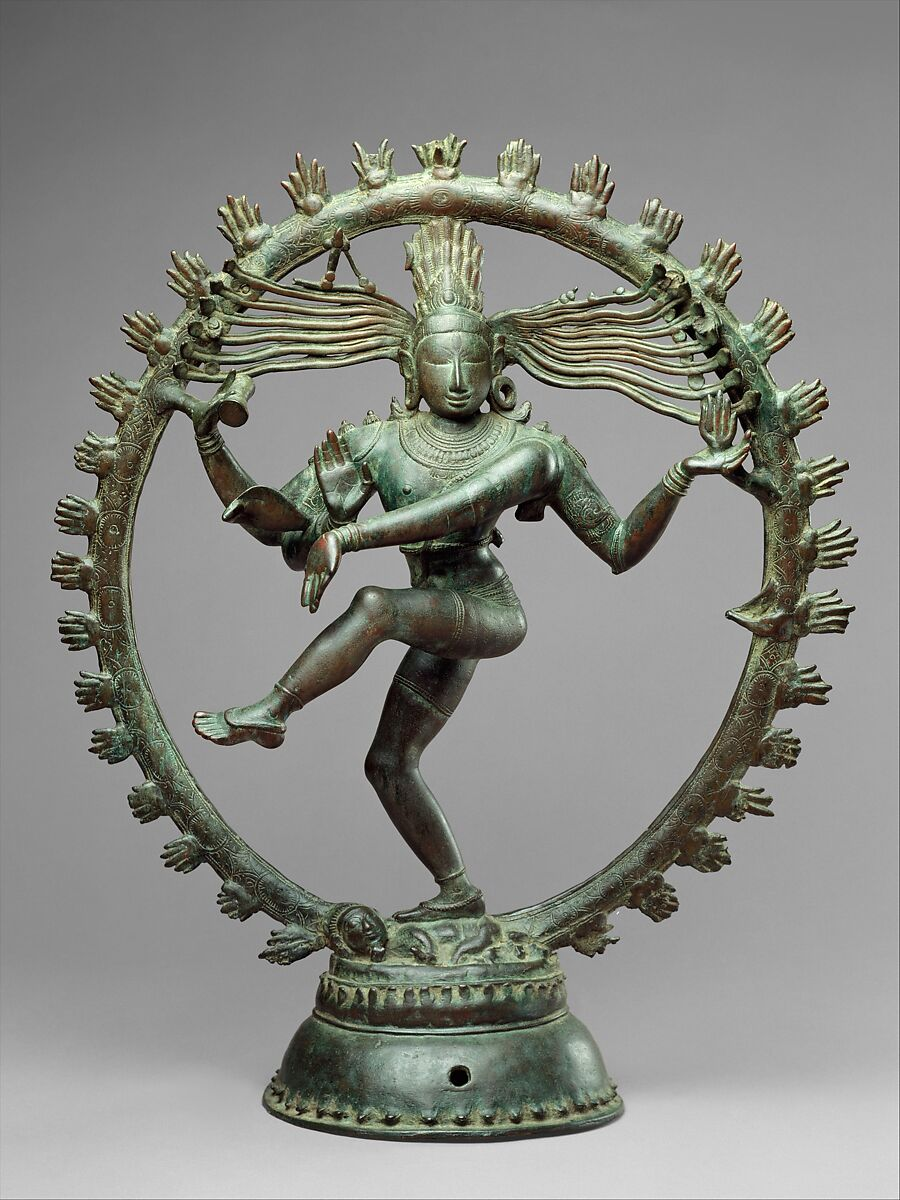
Shiva Nataraja (date & material)
11th century CE; bronze

Shiva Nataraja (use & facts)
Hindu symbol of the Indian concept of never-ending time cycle & combination of Shiva’s images carried in procession & prayed to
Shiva is Hindu god
meant to be epicene (having characteristics of both sexes)
surrounded by nimbus (halo/could)
dances on the dwarf of ignorance
hair flowing = water of Ganges
four hands show four different mudras
drum provides music for dance & beating universe into existence
Nataraja = Lord of the Dance
VERY SYMBOLIC
can be dressed/decorated for procession
when devotee prays in front of statue, Shiva is present

Lakshmana Temple

Lakshmana Temple (culture & location)
Hindu; Khajuraho, India

Lakshmana Temple (date & material)
930-950 CE; brick & carved stone

Lakshmana Temple (use & facts)
Hindu place of worship
Hindu temple architecture reflects its beliefs, Purusa (sacred space/residence of a God), small rooms for priests & individual worshippers, garba griha
garba griha – sacred state kept in small interior room “the Womb of the World”
worshipers here circumambulate the temple outside (encountering Ganesh), then the mithuna, then enter the hypostyle hall & garba griha
sculpture of female nudity
panchayatana puja – act of worship (puja) of five deities: Shiva, Vishnu, Devi, Surya, & Ganesha; temple with 5 shrines/mountains
lion in front that blesses or challenges warrior

Mithuna from Lakshmana Temple
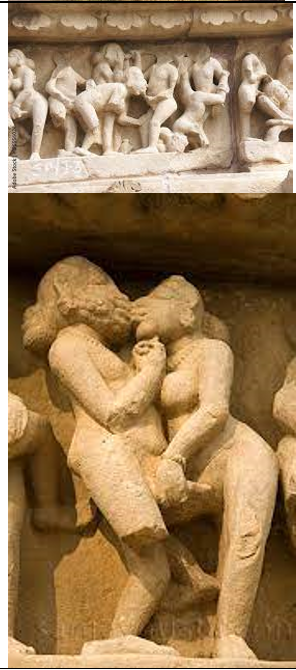
Mithuna from Lakshmana Temple (culture & location)
Hindu; Khajuraho, India

Mithuna from Lakshmana Temple (date & material)
930-950 CE; brick & carved stone

Mithuna from Lakshmana Temple (use & facts)
worshiped for blessings of fertility
female nudity not sinful, but a symbol of fertility & spirituality
end of overt sexuality when colonized by British

Angkor Wat

Angkor Wat (culture & location)
Hindu; Angkor, Cambodia

Angkor Wat (date & material)
c. 800-1500 CE; stone masonry & sandstone

Angkor Wat (use & facts)
Hindu, then Buddhist temple; built to legitimize rule of Khmer king
largest religious monument in the world, covers 400+ acres
name translates to “temple city”
Buddhist temple complex in north Cambodia, originally Hindu temple built in 12th century by Emperor Suryavarman II
originally dedicated to Vishnu, legitimized Suryavarman II’s rule
Khmer tradition = each king must construct mountain temple to express power & legitimize their rule
became Buddhist temple by end of 12th century
no longer an active temple, never abandoned but gradually fell into disuse
“rediscovered” in 1840s by French explorer Henri Mouhot
temple design represents Mount Meru (home of gods in Hindu & Buddhist faiths)
created using water engineering system
has a moat & 15ft high wall, sandstone causeway main access point
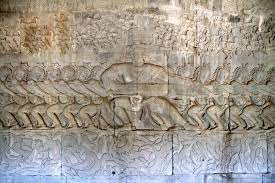
Churning of the Ocean of Milk
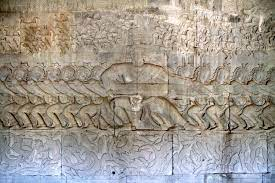
Churning of the Ocean of Milk (culture & location)
Hindu, Angkor, Cambodia
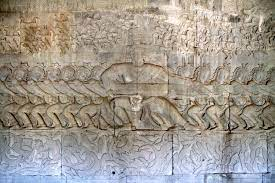
Churning of the Ocean of Milk (date & material)
c. 800-1500 CE; stone masonry & sandstone
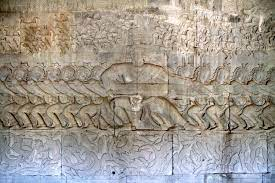
Churning of the Ocean of Milk (ues & facts)
relief found in Angkor Wat
shows Hindu creation story
elixir of immortality (amrita) lost in cosmic sea, retrieving it has cooperation between gods (devas) & demons (asuras) where serpent Vasuki is churning stick rotating around Mount Mandara which sinks & must be supported by giant turtle (incarnation of Vishnu); tug of war goes on for thousands of years until elixir found & released